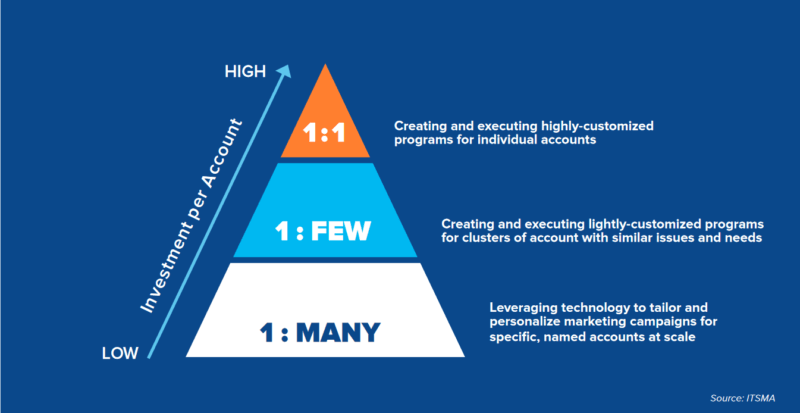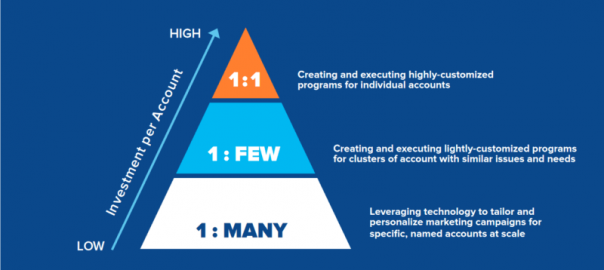The target account list forms the foundation of Account-Based Marketing. Contributor Peter Isaacson explains different approaches and ideas you can employ for assembling this key strategic element.

One of the biggest misconceptions people have about Account-Based Marketing (ABM) is that it takes a lot of work to get an ABM program off the ground.
Too often, B2B marketers are scared off by consultants telling them that they need six months to undergo a change management exercise or an army of contractors or technologies to map processes and fill out templates. The truth is, you can actually stand up an ABM program pretty quickly and get strong results.
In fact, I would argue that the best way to get going with an ABM strategy is to start simply, move quickly and then expand from there. All you really need is a room of smart marketing and sales folks, a rough understanding of the companies you want to go after, and you’re off to the races.
In the article below, I’ll share how you can create, operationalize and maintain your target account list in a few easy steps.
Building your list
Selecting the right accounts is perhaps the most important aspect of any ABM program. But when it comes to actually going through the process, there isn’t a set formula to follow. In fact, there are several ways you can approach building your list:
1. Use an existing list. Chances are, your sales team already has a list of accounts they’re actively working against. You can use this list as a stepping stone for your ABM efforts and work with sales to refine and iterate on those accounts.
2. Identify segments within your CRM system. Partner with sales to identify accounts within your customer relationship management (CRM) system that best fit your Ideal Customer Profile (ICP).
For those of you who need a quick refresher on ICPs, here’s a great explanation from research firm TOPO:
“An ICP defines the firmographic, environmental and behavioral attributes of accounts expected to become a company’s most valuable customers.”
Your ICP should focus on relevant characteristics of your target accounts, including industry, geography, revenue, budget and so on.
3. Invest in predictive and look-alike modeling. Predictive and look-alike modeling technology identifies the companies that most resemble the accounts you’ve had success with in the past. This approach reflects the benchmark characteristics of your best customers while extending beyond your CRM database.
4. Layer in intent data. Invest in an account selection technology that brings intent data into the equation. This allows you to identify and target high-value accounts that are showing buying signals in your company and products.
While this is proving to be the most effective solution for B2B marketers, bear in mind that your target account list shouldn’t be made entirely of accounts that are showing intent. You still want to attract and engage accounts that haven’t heard of you yet. As a result, the most sophisticated marketers are combining this approach with predictive tools to build their lists.
While there are several approaches to building a target account list, it’s important to note that these methods aren’t mutually exclusive. Depending on what you already have in place and how you’re able to scale, a combination of these approaches may very well be the right approach for your team.
Operationalizing your list
After you’ve formalized your list, you’ll need to narrow down your view by breaking the list up into specific segments. Segmenting will make building and executing marketing programs that much easier and effective. Some common segments for B2B include verticals, company size, geography, customers, partner and sales stage.
You can also get more sophisticated in your approach by adopting a blended ABM model, which involves segmenting your target account list by strategic importance: high-value accounts at the top, mid-range accounts in the middle and the rest of your target accounts at the bottom.
This approach allows you to prioritize your accounts and employ a different set of tactics for each tier. For instance, high-value accounts may receive a mix of account-based advertising, website personalization, invitations to field events and high-touch direct mail tactics (1:1), while lower tiers receive just account-based advertising and website personalization (1:few or 1:many).

Once you’ve selected your segments and run marketing programs to them, you’ll want to compare the performance across those segments. An ABM analytics tool can help you make those comparisons across your funnel, from advertising to pipeline and closed revenue. Based on how your segments perform, you can make decisions about growing your list.
Maintaining your list
After you’ve built and segmented your target account list, you’ll want to put a process in place for maintaining it. This means you’ll need to create an ABM leadership team — a specific interdepartmental group of people from marketing, sales and finance who are responsible for managing the target account list and tracking its progress.
At my company, we have something called a “Funnel Working Group,” which meets biweekly to review metrics and understand how we’re pacing to goal. We typically iterate on our target account list on a quarterly basis, but that’s a standard best practice — depending on your stage and experience, you can review and refresh your list more frequently, on a biweekly or monthly basis. This doesn’t mean you have to completely remake your list, but you should spend some time removing closed accounts and bringing in new opportunities that are showing intent signals.
Keep in mind that only a portion of your revenue will come from this list. A strong ABM strategy within a company typically delivers in the range of 65 percent of its pipeline from its target accounts. Therefore, you will have some inbound activity that will lead the business, but the focus is typically on your target accounts. You’ll want to understand how many leads are coming in from your target account list and how that percentage is changing over time.
It’s not uncommon for B2B companies to change out 10 percent of their target accounts each quarter based on accounts they’ve won, lost and new ones that are showing intent.
Finally, based on how your target account list is performing, you’ll want to work with your ABM leadership team to build a plan to scale your efforts. There are two ways to go about this:
- Scale horizontally: Add more accounts to your target account list. You can add more segments or increase the number of accounts you’re targeting by strategic importance.
- Scale vertically: Rather than bringing in new segments or accounts, go deeper into existing segments with more targets. You can also extend your research budget and devote resources to understanding those segments better.
Conclusion
A solid target account list sets the stage for launching your ABM strategy. While there are multiple ways to create, segment and scale your list, always remember that it’s an ongoing process and can be tweaked and improved upon as you get further into your ABM implementation.
Opinions expressed in this article are those of the guest author and not necessarily Marketing Land. Staff authors are listed here.
Marketing Land – Internet Marketing News, Strategies & Tips
(122)
Report Post








